In recent years, the world of kitchen design has witnessed a remarkable resurgence of a once-popular trend: handleless cabinets. This sleek and minimalist approach to cabinetry has captured the imagination of homeowners and interior designers alike, offering a perfect blend of aesthetics and practicality. As we delve into the world of handleless kitchen cabinets, we’ll explore their various styles, benefits, and considerations, helping you make an informed decision for your next kitchen renovation.
The concept of handleless cabinets may seem straightforward, but there’s more to this design trend than meets the eye. From the subtle elegance of true handleless systems to the practicality of push-to-open mechanisms, we’ll uncover the diverse options available in the market. We’ll also address common concerns, such as cleaning and maintenance, to ensure you have a comprehensive understanding of what it means to embrace this modern kitchen aesthetic.
Whether you’re a fan of contemporary design or simply looking to maximize space in your kitchen, handleless cabinets offer a versatile solution that caters to various tastes and needs. Join us as we explore the ins and outs of this innovative cabinetry style, and discover how it can transform your kitchen into a sleek, functional, and timeless space.
- The Evolution of Handleless Kitchen Cabinets
- Understanding Handleless Cabinet Systems
- Advantages of Handleless Kitchen Cabinets
- Potential Drawbacks and Considerations
- Choosing the Right Handleless System for Your Kitchen
- Installation and Maintenance of Handleless Cabinets
- Integrating Handleless Cabinets into Different Kitchen Styles
- The Future of Handleless Kitchen Design
- Conclusion: Making the Right Choice for Your Kitchen
The Evolution of Handleless Kitchen Cabinets
A Brief History of Handleless Design
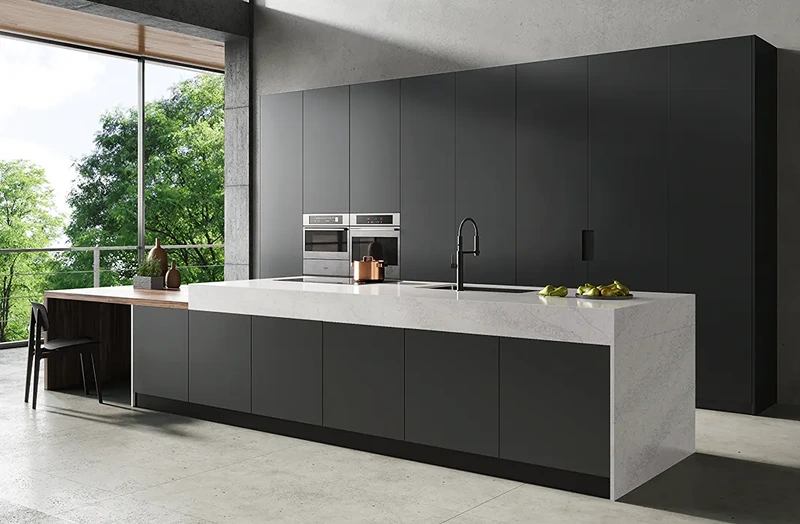
The concept of handleless kitchen cabinets isn’t a new phenomenon. In fact, this design approach first gained popularity in the 1960s and 1970s, coinciding with the rise of modernist architecture and interior design. During this era, clean lines and minimalist aesthetics were highly sought after, making handleless cabinets a natural fit for forward-thinking homeowners.
However, as design trends shifted towards more ornate and traditional styles in the following decades, handleless cabinets temporarily fell out of favor. It wasn’t until the early 2000s that this sleek design began to make a comeback, driven by a renewed interest in minimalism and the growing influence of European kitchen design.
The Resurgence of Minimalism in Kitchen Design
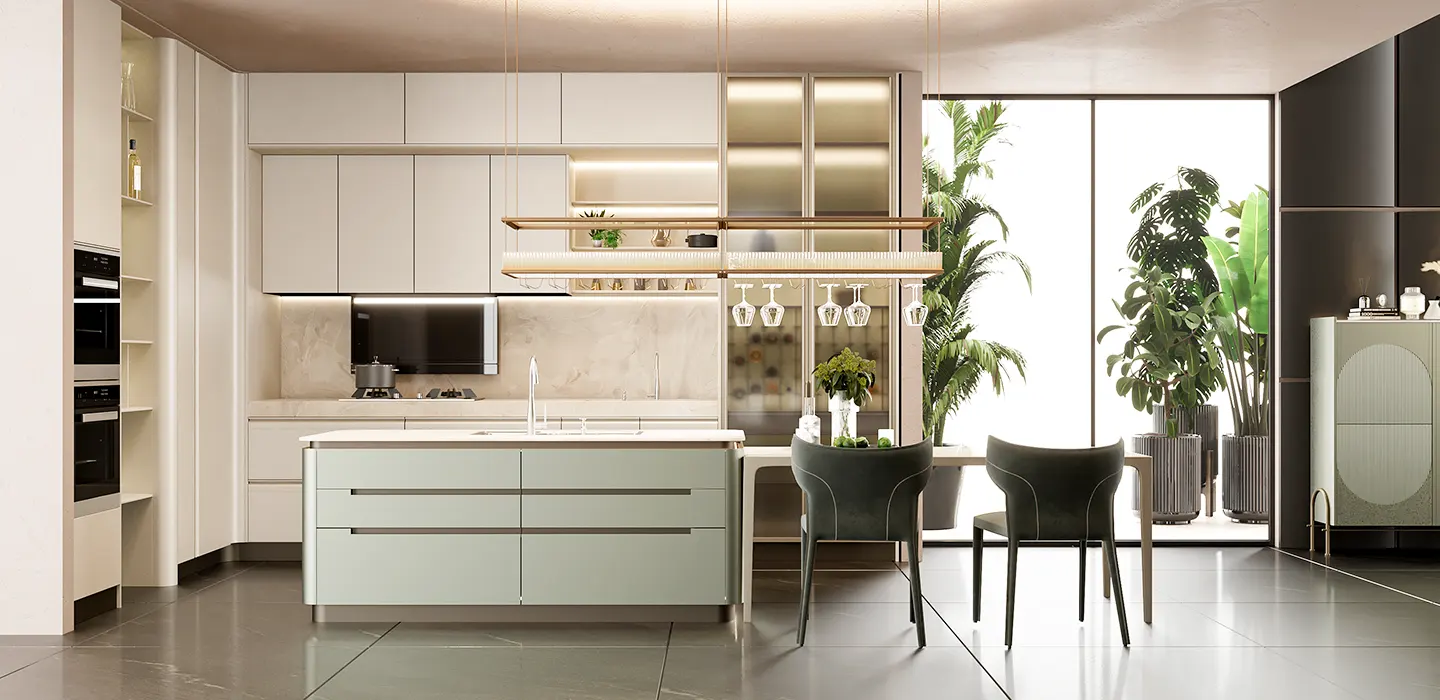
In recent years, there has been a notable shift towards simplicity and functionality in home interiors. This trend has been particularly evident in kitchen design, where clutter-free spaces and streamlined aesthetics have become increasingly desirable. The resurgence of handleless cabinets aligns perfectly with this movement, offering a way to create a clean, uninterrupted look in the heart of the home.
The appeal of handleless kitchens goes beyond mere aesthetics. As urban living spaces have become more compact, the need for space-saving solutions has grown. Handleless cabinets contribute to a sense of openness and fluidity in the kitchen, making them an ideal choice for smaller apartments and open-plan living areas.
Technological Advancements in Cabinetry
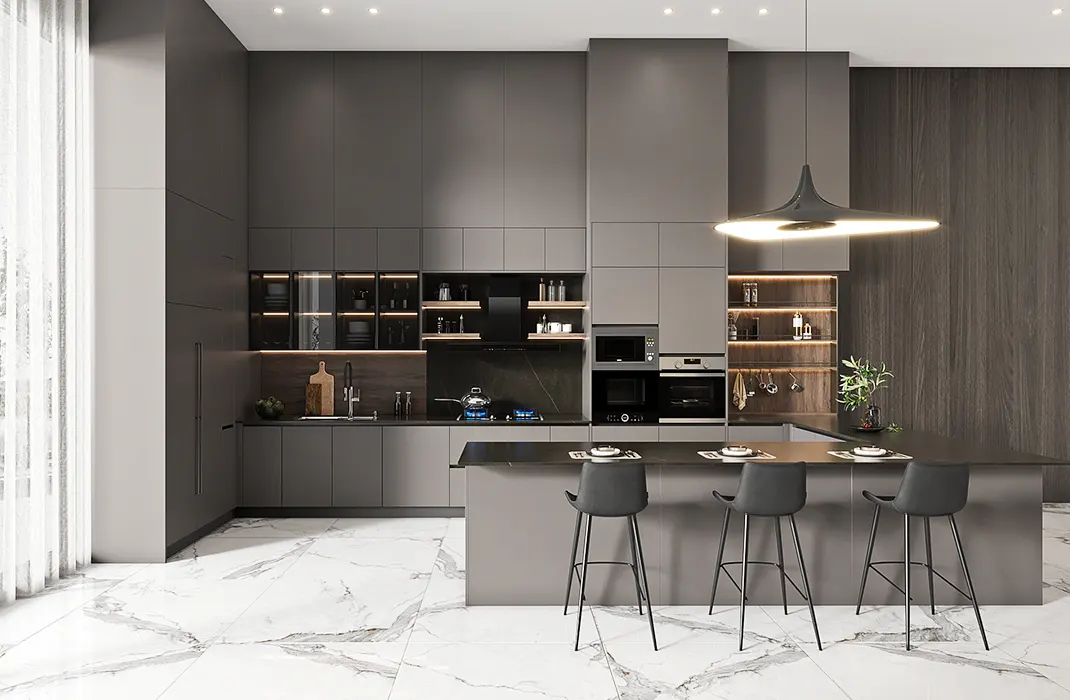
The revival of handleless kitchen cabinets has been further fueled by advancements in cabinetry technology. Modern manufacturing techniques have made it possible to create more precise and durable handleless systems, addressing some of the functional concerns that may have existed in earlier iterations.
For instance, the development of sophisticated push-to-open mechanisms and integrated grip channels has improved the usability of handleless cabinets, making them a practical choice for everyday use. These innovations have helped to bridge the gap between form and function, allowing homeowners to enjoy the sleek look of handleless design without sacrificing convenience.
Understanding Handleless Cabinet Systems
What Defines a Handleless Cabinet?
At its core, a handleless cabinet is characterized by the absence of visible knobs, pulls, or handles on its exterior. Instead, these cabinets rely on alternative opening mechanisms that are either integrated into the cabinet’s design or hidden from view. This creates a smooth, uninterrupted surface across the cabinetry, resulting in a clean and modern aesthetic.
However, it’s important to note that not all handleless cabinets are created equal. There are several different approaches to achieving the handleless look, each with its own unique characteristics and benefits. Understanding these variations can help you choose the right system for your kitchen.
Types of Handleless Cabinet Systems
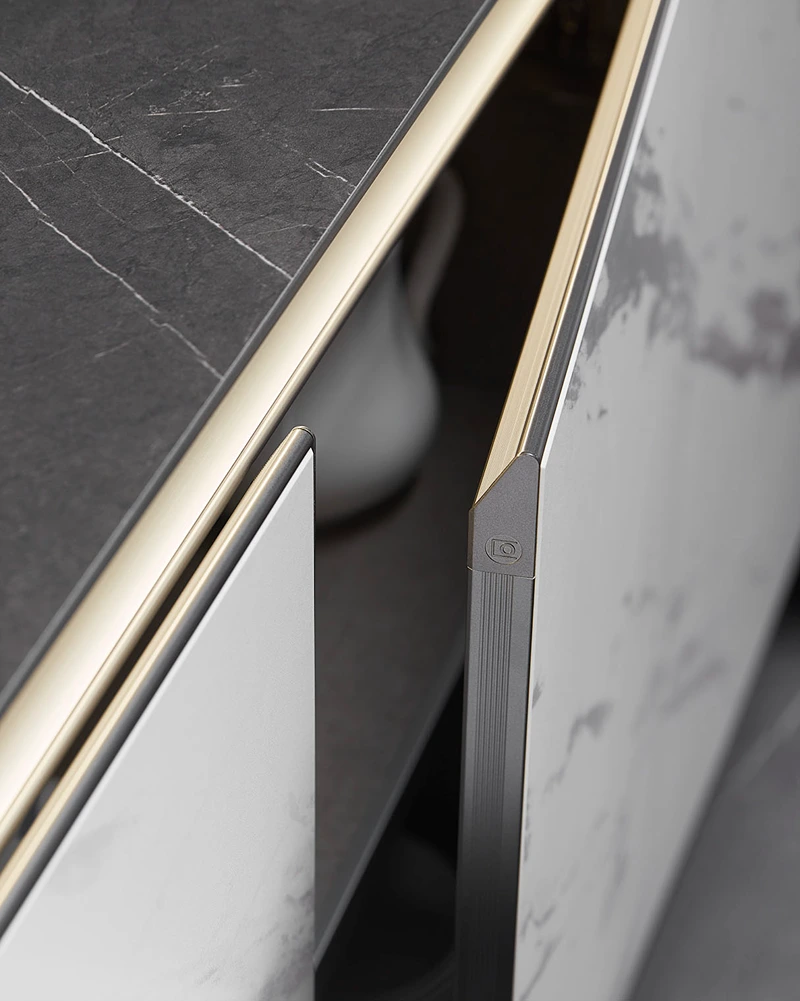
- True Handleless Cabinets:
- Feature a recessed channel or rail behind the cabinet front
- Allow fingers to grip and pull open doors and drawers
- Offer a completely seamless appearance
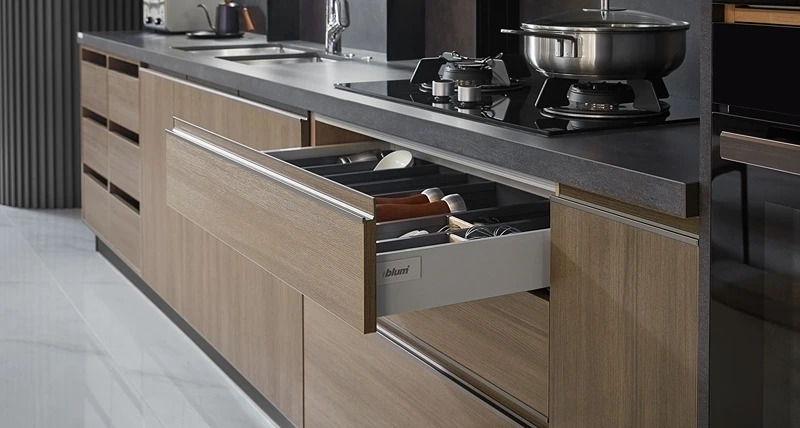
2. J-Pull or C-Channel Cabinets:
- Incorporate a J-shaped groove or C-shaped channel into the cabinet edge
- Provide a built-in grip for opening
- Balance aesthetics with practicality
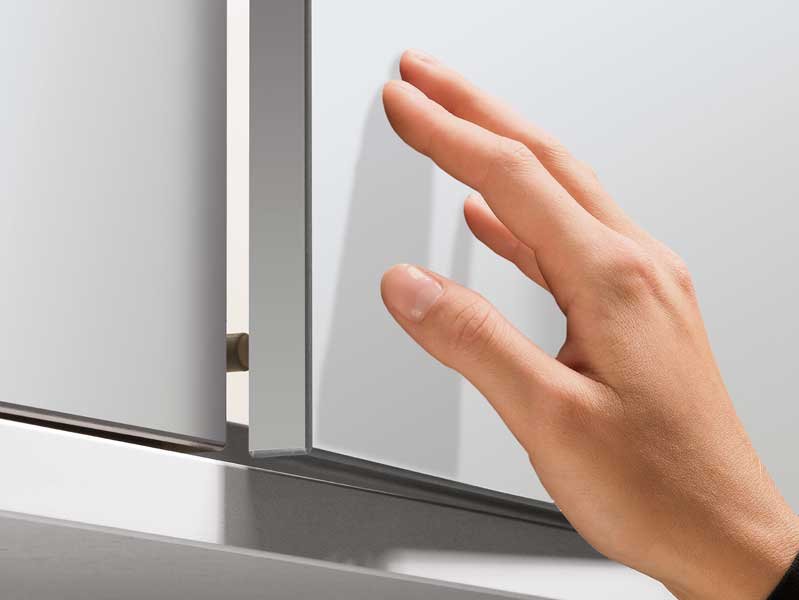
3. Push-to-Open Mechanisms:
- Utilize spring-loaded or magnetic systems
- Open with a gentle push on the cabinet front
- Create a truly minimalist look with no visible opening features
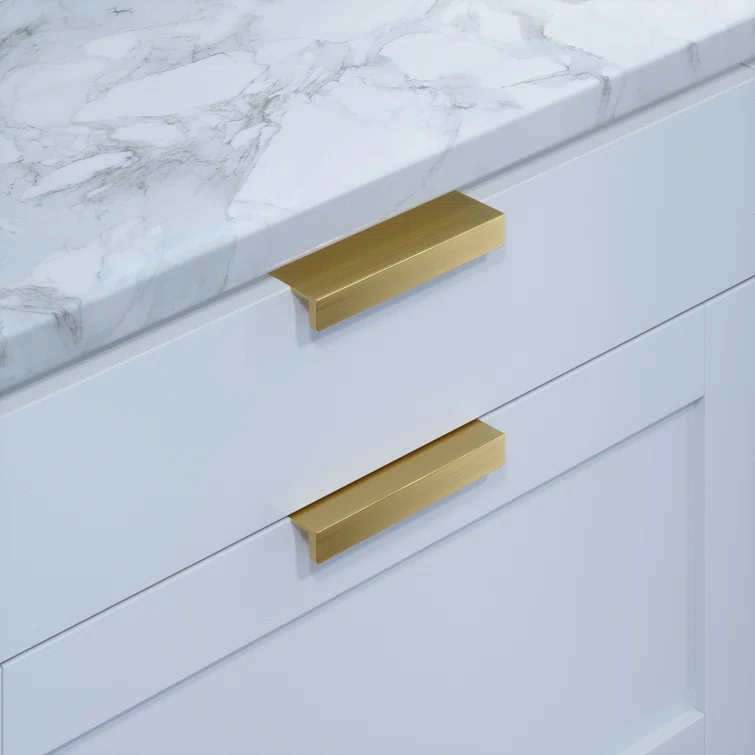
4. Finger Pull or Lip Pull Designs:
- Feature a small lip or edge that extends slightly from the cabinet
- Allow for easy gripping while maintaining a streamlined appearance
- Offer a compromise between handleless and traditional designs
The Mechanics Behind Handleless Systems
The functionality of handleless cabinets relies on clever engineering and innovative design solutions. For true handleless systems, a metal or plastic channel is typically installed behind the cabinet fronts. This channel creates a space for fingers to grip, allowing users to pull open doors and drawers with ease.
Push-to-open mechanisms, on the other hand, often employ spring-loaded devices or magnetic catches. When pressure is applied to the cabinet front, these mechanisms release, causing the door or drawer to pop open slightly. Some advanced systems even incorporate soft-close features, ensuring a smooth and quiet operation.
J-pull and finger pull designs take a more straightforward approach, integrating the opening mechanism directly into the cabinet’s shape. These systems often rely on ergonomically designed edges or grooves that provide a natural grip point for users.
Advantages of Handleless Kitchen Cabinets
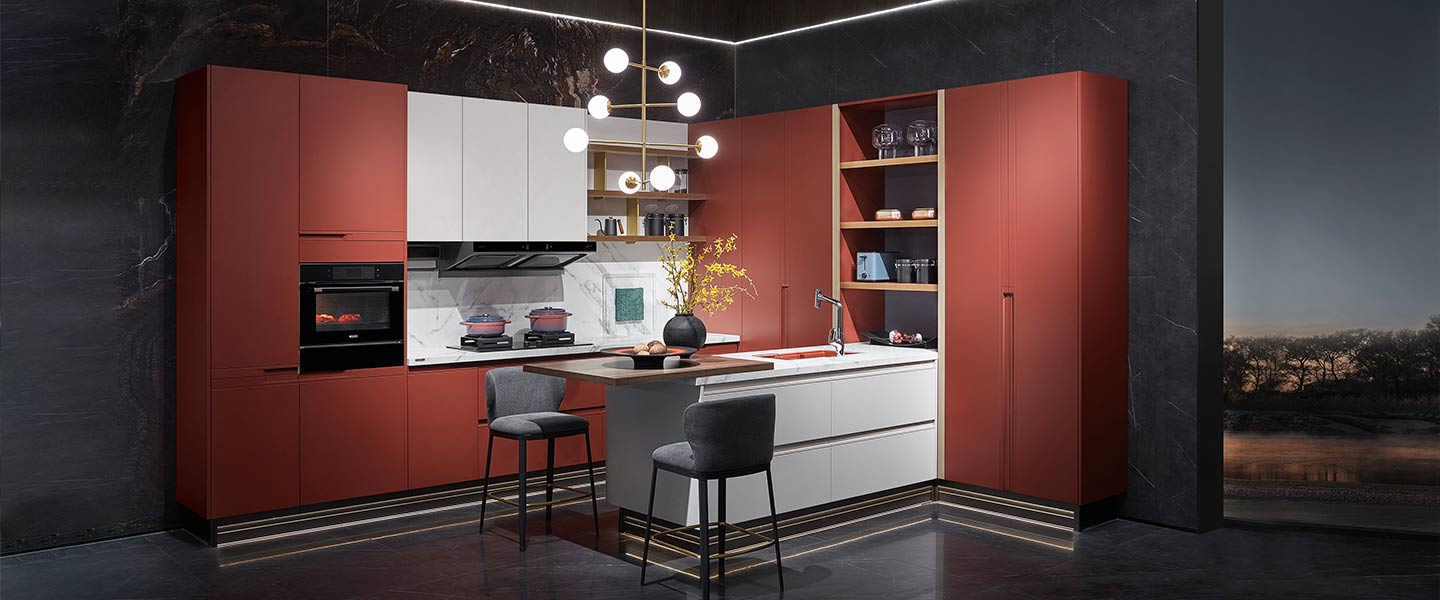
Aesthetic Appeal and Modern Design
One of the primary reasons homeowners opt for handleless kitchen cabinets is their sleek and contemporary appearance. The absence of visible hardware creates a clean, uncluttered look that can make even the busiest kitchen feel more organized and spacious. This minimalist aesthetic is particularly well-suited to modern and contemporary interior styles, but it can also complement transitional or even traditional kitchens when executed thoughtfully.
The smooth, uninterrupted lines of handleless cabinets contribute to a sense of visual calm and order. This can be especially beneficial in open-plan living spaces, where the kitchen needs to harmonize with adjacent dining and living areas. The seamless look of handleless cabinetry helps to create a cohesive and sophisticated atmosphere throughout the space.
Space-Saving Benefits
In addition to their aesthetic advantages, handleless cabinets offer practical space-saving benefits. Traditional cabinet handles and knobs protrude from the cabinet surface, which can be problematic in tight spaces or high-traffic areas. Handleless designs eliminate this issue, allowing for smoother movement around the kitchen and reducing the risk of catching clothing or bumping into protruding hardware.
This space-saving aspect is particularly valuable in smaller kitchens or galley-style layouts, where every inch counts. The flush surfaces of handleless cabinets can make narrow walkways feel more open and accessible, improving the overall functionality of the space.
Enhanced Safety Features
Safety is another important consideration when it comes to kitchen design, especially for households with young children or elderly members. Handleless cabinets offer several safety advantages:
- No protruding elements to bump into or catch on clothing
- Reduced risk of injury from sharp edges or corners on traditional handles
- Fewer places for dust and bacteria to accumulate, promoting a more hygienic environment
For families with young children, the smooth surfaces of handleless cabinets can also make it more challenging for little ones to open drawers and cabinets, providing an added layer of childproofing without the need for additional safety devices.
Versatility in Design Options
Contrary to what some might assume, opting for handleless cabinets doesn’t limit your design choices. In fact, this style of cabinetry can be incredibly versatile, adapting to a wide range of kitchen aesthetics. Here are some ways handleless cabinets can be customized to suit different tastes:
- Material Selection: From high-gloss lacquer to natural wood veneers, handleless cabinets can be crafted from various materials to achieve different looks.
- Color Palette: The clean lines of handleless designs provide an excellent canvas for both bold color choices and subtle, neutral tones.
- Texture Play: Mixing smooth surfaces with textured elements can create visual interest while maintaining the overall sleek appearance.
- Integration with Appliances: Handleless systems can be extended to integrated appliances, creating a seamless look across the entire kitchen.
- Lighting Effects: The absence of handles allows for creative use of under-cabinet or in-cabinet lighting to enhance the overall ambiance.
By offering this level of design flexibility, handleless cabinets can cater to a broad spectrum of personal styles and preferences, making them a versatile choice for many homeowners.
Potential Drawbacks and Considerations
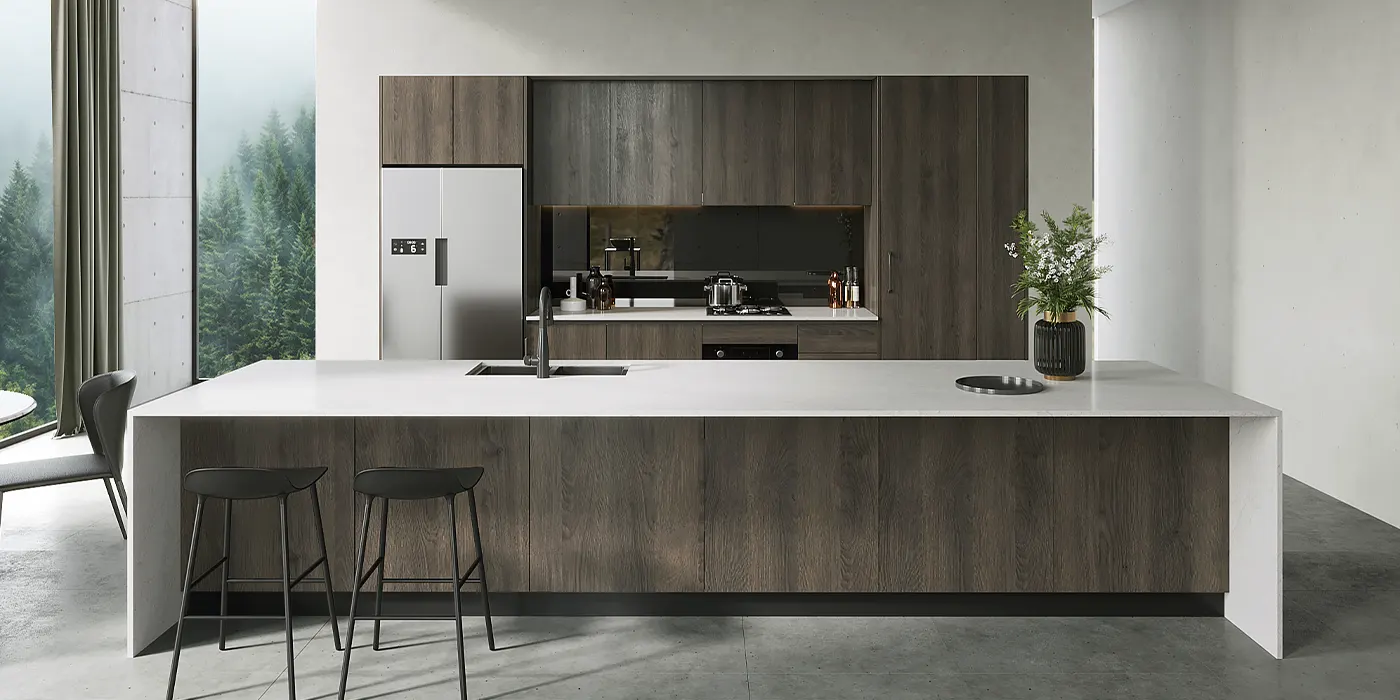
Cleaning and Maintenance Challenges
While handleless kitchen cabinets offer a sleek and modern appearance, they do come with some unique cleaning and maintenance considerations. The absence of traditional handles means that users must touch the cabinet surfaces more frequently, which can lead to increased fingerprints and smudges, especially on high-gloss finishes.
Additionally, the recessed channels or grooves used in some handleless designs can accumulate dust, crumbs, and other debris over time. This may require more frequent and thorough cleaning to maintain a pristine appearance. Here are some tips for addressing these challenges:
- Choose finishes that are resistant to fingerprints and smudges, such as matte or textured surfaces.
- Use a microfiber cloth for regular cleaning to avoid scratching delicate surfaces.
- Invest in a small, soft-bristled brush to clean recessed channels and grooves effectively.
- Consider applying a protective coating to high-gloss surfaces to make cleaning easier.
Cost Implications
It’s important to note that handleless kitchen cabinets often come with a higher price tag compared to traditional cabinet designs. This increased cost can be attributed to several factors:
- Specialized Manufacturing: The production of handleless cabinets requires precise engineering and specialized components, which can drive up manufacturing costs.
- Installation Complexity: Installing handleless systems, particularly true handleless designs with recessed channels, may require more skill and time, potentially increasing labor costs.
- Quality Materials: To ensure durability and smooth operation, handleless cabinets often utilize high-quality materials and mechanisms, which can contribute to the overall cost.
- Custom Design: Many handleless kitchens are custom-designed to achieve a seamless look, which can be more expensive than off-the-shelf options.
While the initial investment may be higher, many homeowners find that the long-term benefits and timeless appeal of handleless cabinets justify the additional expense.
Functionality for All Users
When considering handleless cabinets, it’s crucial to think about the needs of all potential users in the household. While many people find handleless designs easy to use, some individuals may face challenges:
- Elderly Users: Those with arthritis or limited hand strength may find it more difficult to grip and open handleless cabinets, particularly push-to-open systems.
- Users with Long Nails: Individuals with long nails might find it uncomfortable to use certain handleless designs, especially those with narrow grip channels.
- Children: Depending on the specific handleless system chosen, very young children may struggle to open cabinets independently.
To address these concerns, consider the following solutions:
- Opt for handleless designs with wider grip channels or more pronounced J-pulls for easier access.
- Incorporate a mix of handleless and traditional hardware in less visible areas to accommodate different users’ needs.
- Choose push-to-open systems with adjustable opening force to suit various users’ abilities.
Compatibility with Kitchen Style
While handleless cabinets are incredibly versatile, they may not be the ideal choice for every kitchen style. This design tends to work best in modern, contemporary, or minimalist settings. In more traditional or rustic kitchens, the absence of handles might feel out of place or disrupt the overall aesthetic.
Before committing to handleless cabinets, consider the following:
- Existing Architecture: Evaluate how handleless cabinets will integrate with the existing architectural elements of your home.
- Long-term Design Plans: Think about your long-term design goals and whether handleless cabinets align with your vision for the space.
- Transitional Options: If you’re unsure, consider transitional designs that blend handleless elements with more traditional features to create a balanced look.
By carefully weighing these factors, you can determine whether handleless cabinets are the right choice for your kitchen and lifestyle.
Choosing the Right Handleless System for Your Kitchen
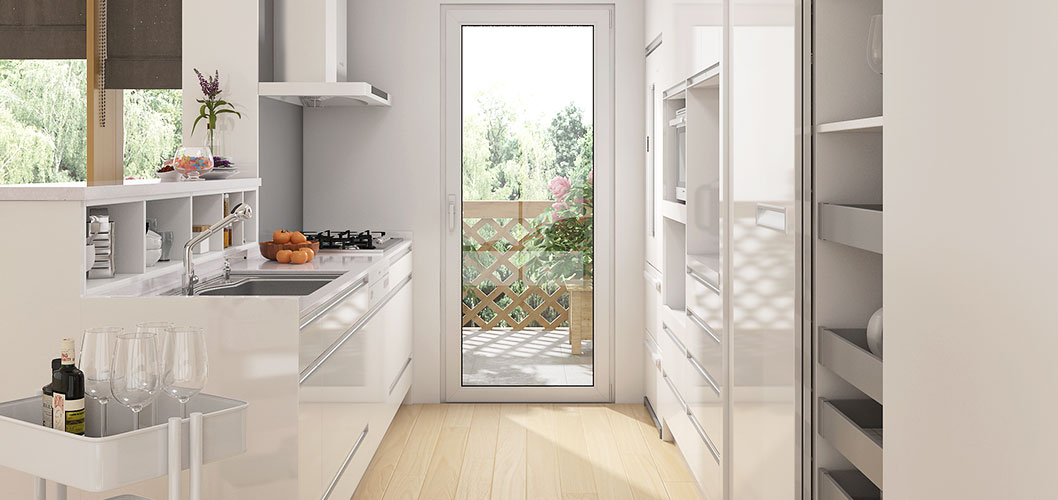
Assessing Your Kitchen Layout and Workflow
Before selecting a handleless cabinet system, it’s crucial to evaluate your kitchen’s layout and how you typically move within the space. Consider the following factors:
- Traffic Flow: Analyze the main pathways in your kitchen and how handleless cabinets might impact movement.
- Work Zones: Identify your primary work areas (cooking, prep, cleaning) and ensure the chosen handleless system complements these zones.
- Cabinet Accessibility: Think about which cabinets are used most frequently and whether a particular handleless design would enhance or hinder access.
- Appliance Integration: Consider how handleless cabinets will integrate with your appliances, especially if you’re opting for a seamless look.
By mapping out your kitchen’s functionality, you can make an informed decision about which handleless system will best support your daily routines and habits.
Comparing Different Handleless Mechanisms
Each type of handleless cabinet system has its own set of advantages and potential drawbacks. Here’s a comparison to help you choose the right option for your kitchen:
- True Handleless (Recessed Channel):
- Pros: Sleek appearance, consistent look across all cabinets
- Cons: Can collect dust and debris, may be more expensive to install
- J-Pull / C-Channel:
- Pros: Easy to use, more affordable than true handleless
- Cons: Less seamless appearance, limited design options
- Push-to-Open:
- Pros: Completely smooth exterior, satisfying to use
- Cons: May require more force to open, potential for misalignment over time
- Finger Pull / Lip Pull:
- Pros: Balance of aesthetics and functionality, easier for all users
- Cons: Less minimalist than other options, can accumulate dirt in the lip
Consider testing different mechanisms in person to get a feel for their operation and determine which suits your preferences best.
Material and Finish Considerations
The choice of material and finish for your handleless cabinets can significantly impact both their appearance and functionality. Here are some popular options to consider:
- High-Gloss Lacquer:
- Pros: Modern look, easy to clean, reflects light
- Cons: Shows fingerprints easily, can be expensive
- Matte Finishes:
- Pros: Hides fingerprints well, creates a soft, sophisticated look
- Cons: May show wear more quickly, can be challenging to clean
- Wood Veneers:
- Pros: Adds warmth and texture, durable
- Cons: May require more maintenance, limited color options
- Laminate:
- Pros: Affordable, wide range of colors and patterns available
- Cons: May not be as durable as other options, can look less high-end
When selecting a material and finish, consider factors such as durability, ease of cleaning, and how well it complements your overall kitchen design.
Budget Considerations and Long-Term Value
While handleless cabinets may come with a higher initial cost, it’s important to consider their long-term value. Here are some factors to keep in mind when budgeting for your handleless kitchen:
- Durability: High-quality handleless systems can be more durable than traditional hardware, potentially lasting longer and requiring fewer replacements.
- Timeless Appeal: The clean, minimalist look of handleless cabinets tends to age well, reducing the need for frequent updates to keep your kitchen looking modern.
- Energy Efficiency: Some handleless designs, particularly those with integrated channels, can contribute to better insulation and energy efficiency in your kitchen.
- Resale Value: A well-designed handleless kitchen can be a selling point for potential buyers, potentially increasing your home’s value.
When setting your budget, consider not just the upfront costs but also the long-term benefits and potential savings associated with a handleless kitchen design.
Installation and Maintenance of Handleless Cabinets
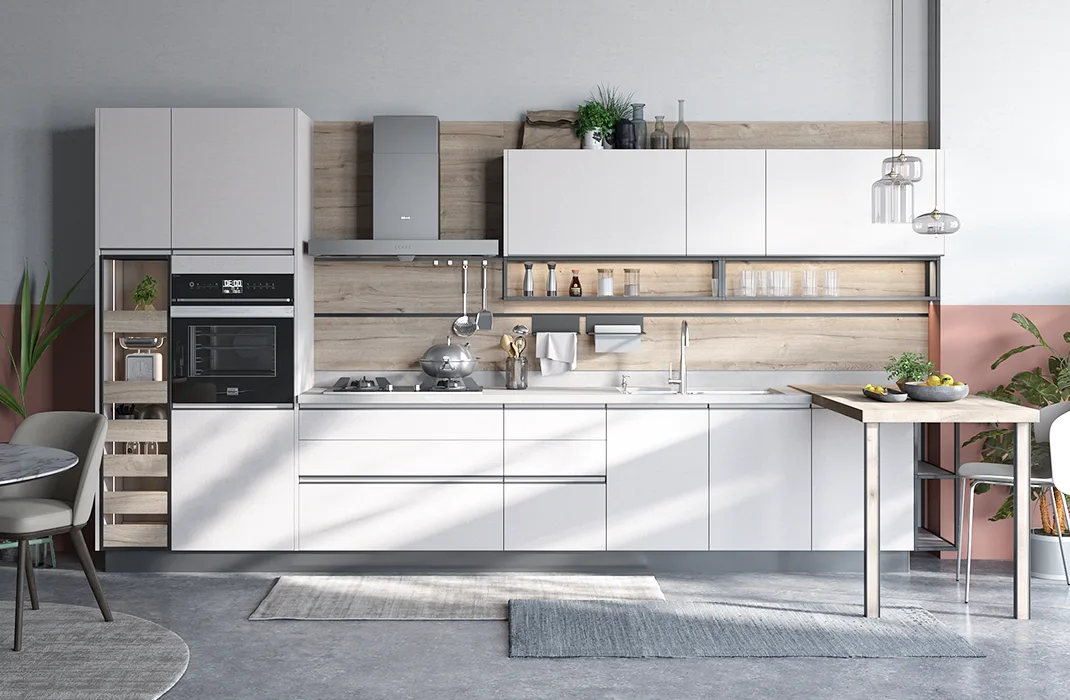
Professional Installation vs. DIY
The installation of handleless cabinets can be more complex than traditional cabinetry, particularly for true handleless systems with recessed channels. Here’s a comparison of professional installation versus DIY approaches:
Professional Installation:
- Ensures precise alignment and functionality
- Typically comes with warranties and guarantees
- Can be more efficient, saving time and potential frustration
- May be required to maintain manufacturer warranties
DIY Installation:
- Can be more cost-effective if you have the necessary skills
- Allows for complete control over the process
- Requires specialized tools and a high level of precision
- Risk of errors that could affect functionality and aesthetics
For most homeowners, professional installation is recommended to ensure the best results and longevity of your handleless cabinet system.
Tips for Maintaining Your Handleless Kitchen
To keep your handleless cabinets looking and functioning their best, follow these maintenance tips:
- Regular Cleaning:
- Wipe down surfaces daily with a soft, damp cloth
- Use mild, non-abrasive cleaners to avoid damaging finishes
- Pay special attention to recessed channels and grip areas
- Addressing Fingerprints and Smudges:
- For high-gloss finishes, use a microfiber cloth to buff out marks
- Consider applying a protective coating to reduce fingerprint visibility
- Lubricating Moving Parts:
- Periodically lubricate hinges and drawer slides to ensure smooth operation
- Use food-safe lubricants in kitchen environments
- Adjusting Alignment:
- Check and adjust door and drawer alignment regularly
- Tighten any loose screws or fittings promptly
- Protecting Surfaces:
- Use cabinet liners to protect interior surfaces from scratches and spills
- Consider applying edge protectors to high-traffic areas
By following these maintenance practices, you can help ensure that your handleless cabinets remain beautiful and functional for years to come.
Troubleshooting Common Issues
Even with proper installation and maintenance, you may encounter some issues with your handleless cabinets over time. Here are some common problems and their solutions:
- Misaligned Doors or Drawers:
- Adjust hinges or drawer slides using manufacturer-provided instructions
- If persistent, consult a professional to avoid damaging the cabinet
- Sticky Push-to-Open Mechanisms:
- Clean the mechanism thoroughly to remove any debris
- Lubricate moving parts with a suitable product
- Replace the mechanism if it continues to malfunction
- Scratches or Chips in Finish:
- Use touch-up kits designed for your specific cabinet material
- For deeper damage, consider professional refinishing services
- Loose or Sagging Cabinets:
- Tighten mounting screws carefully
- Check for and replace any damaged wall anchors
- Consult a professional if structural issues are suspected
- Wear in Grip Channels:
- Clean thoroughly to remove built-up grime
- Consider applying a protective film to high-wear areas
- In severe cases, channel replacement may be necessary
By addressing these issues promptly, you can maintain the functionality and appearance of your handleless kitchen cabinets, ensuring they continue to enhance your space for years to come.
Integrating Handleless Cabinets into Different Kitchen Styles
Modern and Contemporary Kitchens
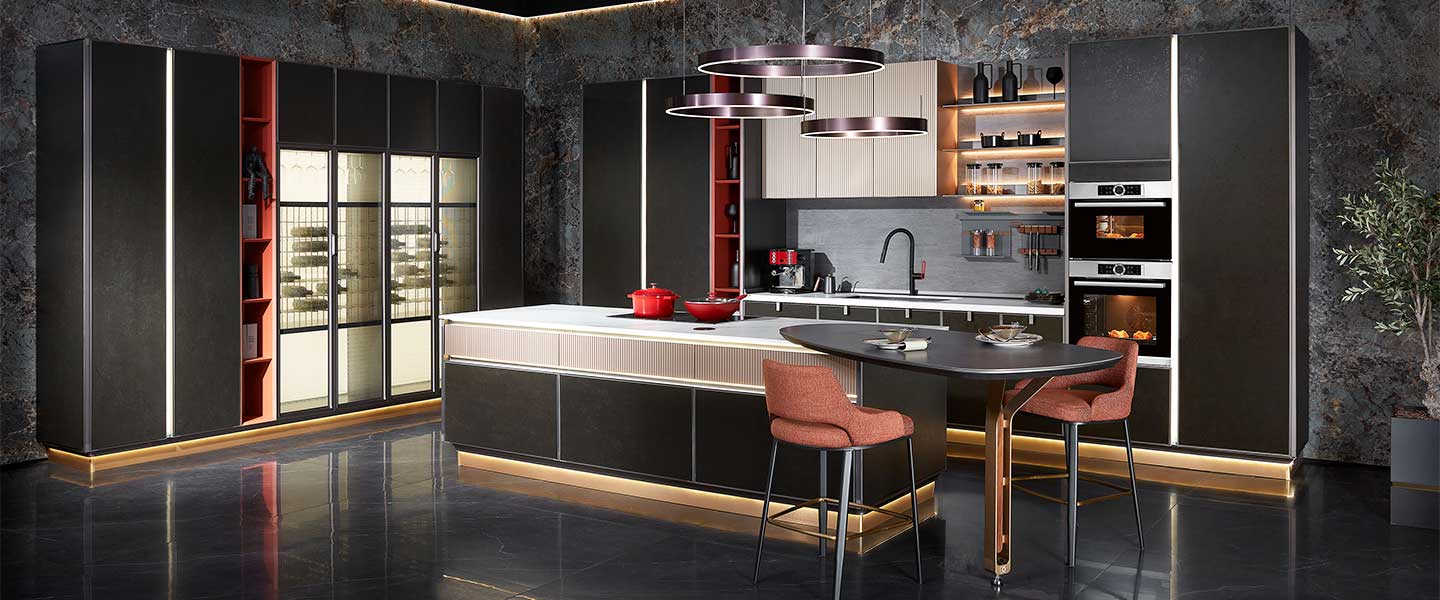
Handleless cabinets are a natural fit for modern and contemporary kitchen designs, where clean lines and minimalist aesthetics reign supreme. Here are some ways to incorporate handleless cabinets into these styles:
- Monochromatic Color Schemes:
- Use a single color across all cabinets for a sleek, unified look
- Experiment with different shades of the same color for subtle depth
- High-Gloss Finishes:
- Opt for glossy surfaces to reflect light and create a sense of spaciousness
- Combine with matte elements for textural contrast
- Integrated Appliances:
- Choose handleless fronts for refrigerators, dishwashers, and other appliances
- Create a seamless flow across the entire kitchen
- Floating Shelves:
- Complement handleless cabinets with open shelving for a balanced look
- Use materials that match or contrast with your cabinet finishes
- Minimalist Hardware:
- Consider magnetic or touch-latch systems for a truly handle-free look
By focusing on simplicity and clean geometries, you can create a stunning modern kitchen that showcases the beauty of handleless cabinetry.
Transitional and Eclectic Kitchens
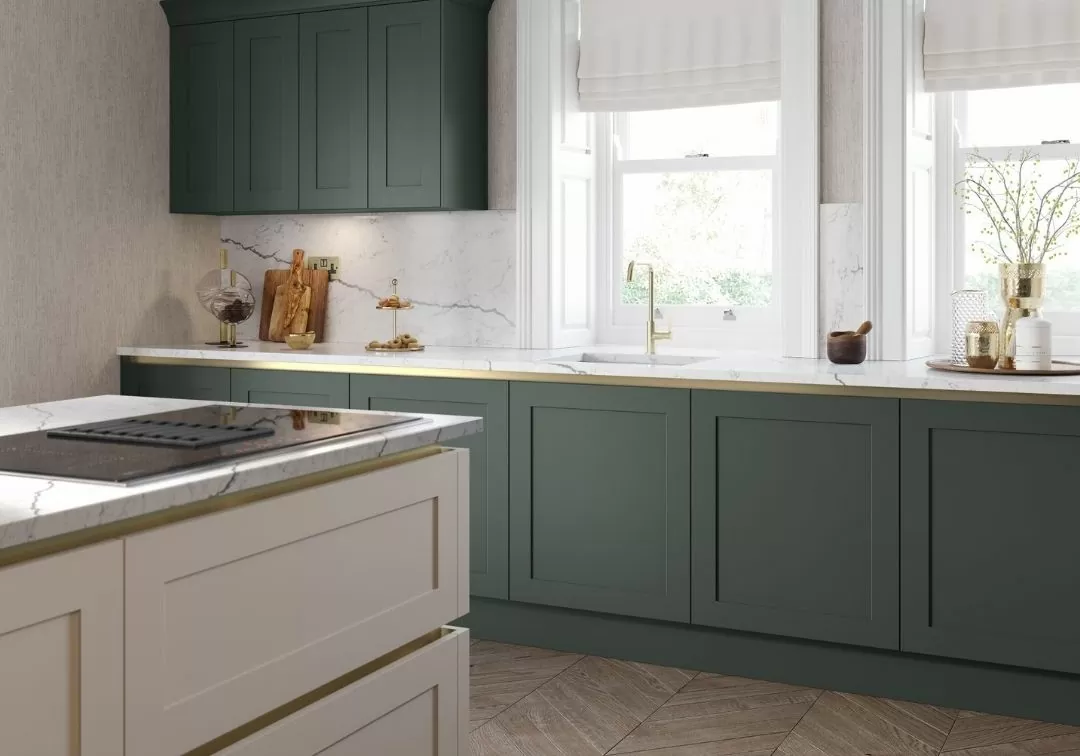
While handleless cabinets are often associated with modern design, they can also work beautifully in transitional and eclectic kitchens. Here’s how to incorporate them effectively:
- Mix and Match:
- Combine handleless cabinets with traditional elements like crown molding
- Use a mix of handleless and handled cabinets for visual interest
- Warm Materials:
- Choose wood veneers or warm-toned laminates for handleless cabinets
- Pair with natural stone countertops for a balanced look
- Textural Contrasts:
- Incorporate textured backsplashes or statement light fixtures
- Use patterned fabrics for window treatments or seating to soften the look
- Color Play:
- Experiment with bold colors for handleless cabinets in an otherwise neutral space
- Use two-tone cabinetry to create visual separation between upper and lower cabinets
- Vintage Accents:
- Introduce vintage or antique elements as counterpoints to sleek cabinetry
- Consider a statement range or hood to add character
By thoughtfully combining handleless elements with more traditional or eclectic features, you can create a unique kitchen that bridges different design styles.
Minimalist and Scandinavian-Inspired Kitchens
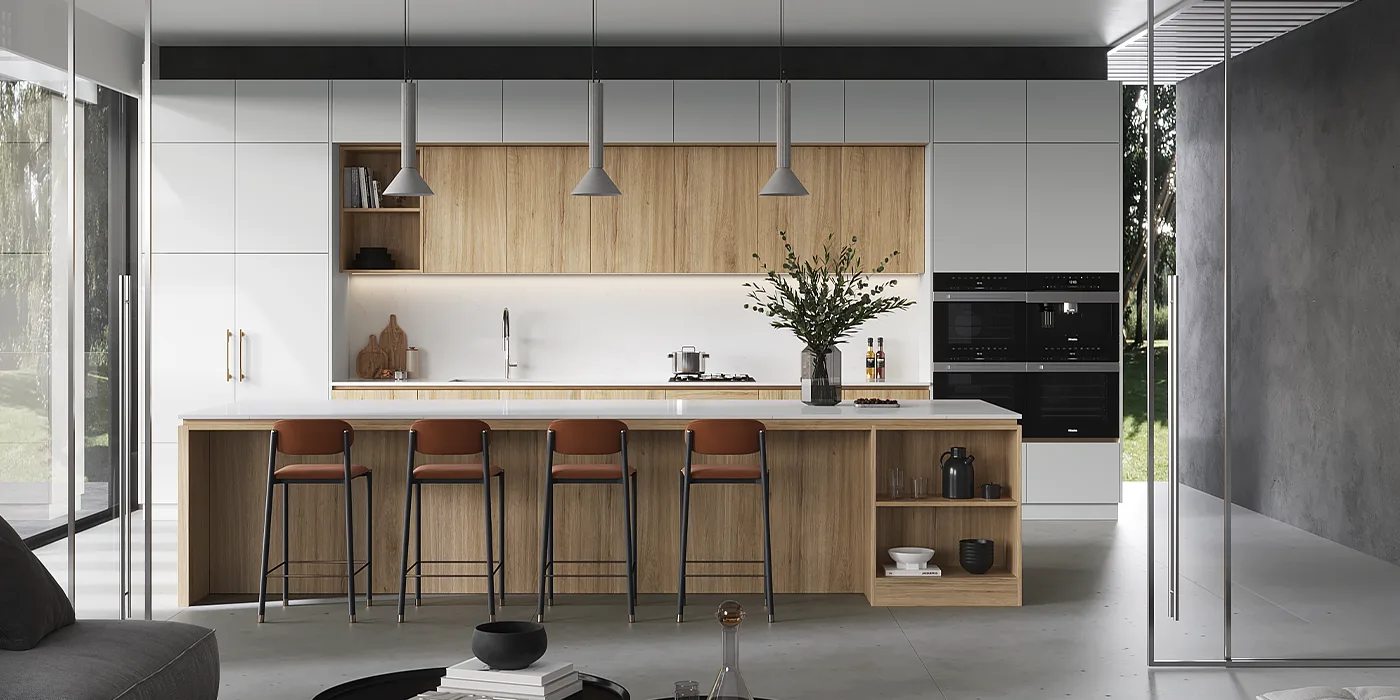
Handleless cabinets are a perfect match for minimalist and Scandinavian-inspired kitchen designs, which prioritize simplicity, functionality, and natural elements. Consider these approaches:
- Light Wood Tones:
- Use light oak or birch veneers for a warm, natural look
- Matte Finishes:
- Opt for matte or low-sheen cabinet finishes to reduce glare and create a soft ambiance
- Choose muted colors like sage green or dusty blue for subtle interest
- Open Shelving:
- Incorporate open shelves alongside handleless cabinets for display and easy access
- Use natural materials like wood or metal for shelving
- Natural Light:
- Maximize natural light with large windows or skylights
- Choose reflective surfaces to amplify available light
- Organic Shapes:
- Soften the linear look of handleless cabinets with rounded dining furniture or curved light fixtures
- Incorporate plants or natural materials to add warmth and texture
By focusing on simplicity, natural materials, and a light color palette, you can create a serene and inviting minimalist or Scandinavian-inspired kitchen that showcases the beauty of handleless cabinetry.
The Future of Handleless Kitchen Design
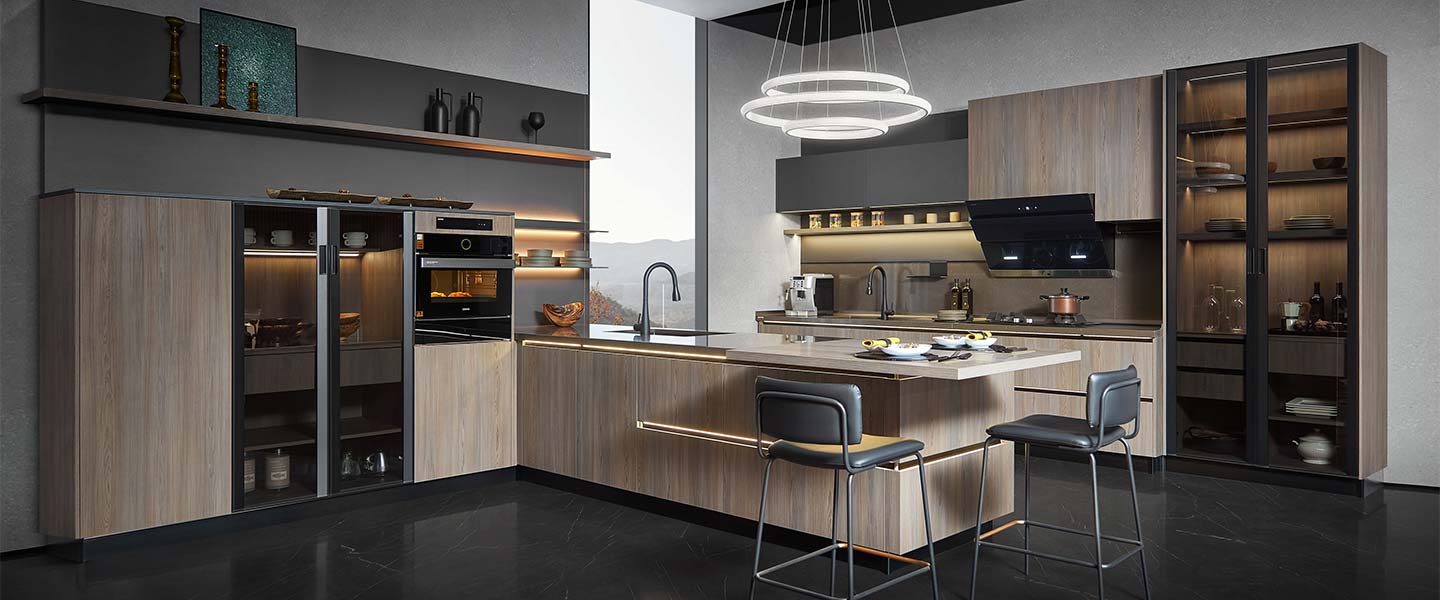
Emerging Trends and Innovations
As kitchen design continues to evolve, handleless cabinets are at the forefront of innovation. Here are some emerging trends and technological advancements to watch:
- Smart Integration:
- Voice-activated opening systems for hands-free operation
- Biometric sensors for personalized access and security
- Advanced Materials:
- Self-healing surfaces that resist scratches and wear
- Antimicrobial finishes for improved hygiene
- Customizable Lighting:
- Integrated LED lighting within grip channels for both function and ambiance
- Color-changing options to suit different moods or occasions
- Eco-Friendly Solutions:
- Sustainable materials like recycled plastics or rapidly renewable woods
- Energy-efficient opening mechanisms that reduce power consumption
- Modular and Adaptable Designs:
- Easily reconfigurable cabinet systems to adapt to changing needs
- Interchangeable fronts for quick style updates
These innovations promise to make handleless kitchens even more functional, personalized, and sustainable in the coming years.
Sustainability and Eco-Friendly Options
As environmental concerns become increasingly important to homeowners, the handleless cabinet industry is responding with more sustainable options:
- Recycled and Upcycled Materials:
- Cabinet fronts made from recycled plastics or reclaimed wood
- Use of eco-friendly composites that reduce reliance on new resources
- Low-VOC Finishes:
- Water-based lacquers and paints that minimize harmful emissions
- Natural oil finishes for wood veneers
- Energy-Efficient Production:
- Manufacturing processes that reduce energy consumption and waste
- Longevity and Repairability:
- Durable designs that reduce the need for replacement
- Modular components that can be easily repaired or updated
- End-of-Life Considerations:
- Recyclable or biodegradable materials for easier disposal
- Take-back programs for responsible recycling of old cabinetry
By choosing eco-friendly handleless cabinet options, homeowners can create beautiful kitchens that align with their environmental values.
Predictions for Long-Term Popularity
As we look to the future, several factors suggest that handleless kitchen cabinets will continue to grow in popularity:
- Urbanization and Space Efficiency:
- As more people move to urban areas, the need for space-saving solutions will increase
- Handleless designs maximize usable space in compact kitchens
- Aging Population:
- Easy-to-use handleless systems may become more appealing to older homeowners
- Innovations in opening mechanisms will cater to a range of physical abilities
- Technological Integration:
- As smart home technology advances, handleless cabinets will likely incorporate more automated features
- This integration will appeal to tech-savvy homeowners and those seeking convenience
- Design Versatility:
- The adaptability of handleless designs to various aesthetics will ensure their relevance across changing style trends
- Customization options will continue to expand, allowing for more personalized expressions
- Health and Hygiene Awareness:
- Post-pandemic, the easy-to-clean nature of handleless cabinets may be increasingly valued
- Innovations in antimicrobial and self-cleaning surfaces will further enhance their appeal
While design preferences will always evolve, the combination of aesthetics, functionality, and adaptability positions handleless kitchen cabinets as a enduring trend in home design.
Conclusion: Making the Right Choice for Your Kitchen
As we’ve explored throughout this comprehensive guide, handleless kitchen cabinets offer a compelling blend of style, functionality, and innovation. Their sleek, minimalist aesthetic can transform a kitchen into a modern masterpiece, while their space-saving design and ease of use make them a practical choice for many homeowners.
However, like any design decision, choosing handleless cabinets requires careful consideration of your specific needs, preferences, and lifestyle. From the various opening mechanisms available to the range of materials and finishes, there are numerous factors to weigh when deciding if handleless cabinets are right for your kitchen.
Remember to consider:
- Your kitchen’s layout and workflow
- The overall style of your home
- Your budget and long-term value expectations
- The needs of all household members
- Maintenance requirements and cleaning considerations
By thoughtfully evaluating these factors and exploring the options available, you can make an informed decision that will result in a kitchen that’s not only beautiful but also perfectly suited to your daily life.
Whether you opt for the seamless look of true handleless cabinets, the practicality of J-pull designs, or a mix of handleless and traditional elements, the key is to create a space that reflects your personal style and meets your functional needs. With the right approach, handleless kitchen cabinets can be the foundation of a stunning, efficient, and timeless kitchen design that you’ll enjoy for years to come.
As kitchen design continues to evolve, handleless cabinets are likely to remain at the forefront of innovation, offering exciting possibilities for homeowners who value both form and function. By staying informed about emerging trends and technologies, you can ensure that your kitchen remains cutting-edge and continues to meet your changing needs over time.
Ultimately, the decision to incorporate handleless cabinets into your kitchen is a personal one. By arming yourself with knowledge and carefully considering your options, you can create a kitchen that’s not just a place for cooking, but a true reflection of your style and a joy to use every day.